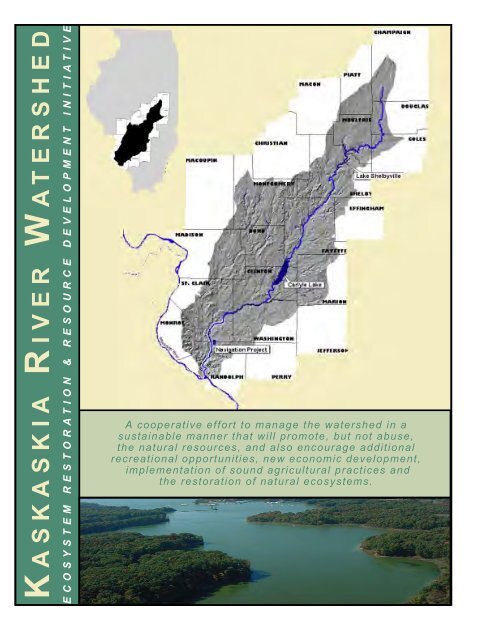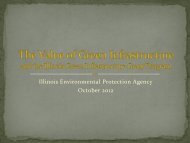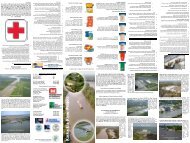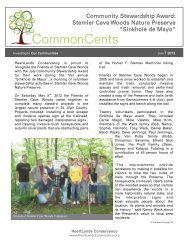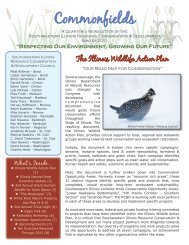Kaskaskia River Watershed - HeartLands Conservancy
Kaskaskia River Watershed - HeartLands Conservancy
Kaskaskia River Watershed - HeartLands Conservancy
Create successful ePaper yourself
Turn your PDF publications into a flip-book with our unique Google optimized e-Paper software.
K ASKASKIA RIVER WATERSHED<br />
ECOSYSTEM RESTORATION & RESOURCE DEVELOPMENT INITIATIVE<br />
A cooperative effort to manage the watershed in a<br />
sustainable manner that will promote, but not abuse,<br />
the natural resources, and also encourage additional<br />
recreational opportunities, new economic development,<br />
implementation of sound agricultural practices and<br />
the restoration of natural ecosystems.
K A S K A S K I A R I V E R W A T E R S H E D<br />
E C O S Y S T E M R E S T O R A T I O N & R E S O U R C E D E V E L O P -<br />
M E N T I N I T I A T I V E<br />
<strong>River</strong>.<br />
I SSUES & OPPORTUNITIES<br />
The <strong>Kaskaskia</strong> <strong>River</strong> <strong>Watershed</strong> Ecosystem Restoration &<br />
Resource Development Initiative is a collaborative effort between<br />
State and Federal Agencies, as well as a number of<br />
local/regional interests, including the <strong>Kaskaskia</strong> <strong>Watershed</strong><br />
Association, that look to jointly manage the watershed in a<br />
manner that will accomplish the following:<br />
• Restore, enhance and protect habitat for plants<br />
and wildlife<br />
• Improve water quality throughout the watershed<br />
• Enhance recreational opportunities on private,<br />
state and federal land<br />
• Increase economic opportunities for agriculture<br />
and business communities<br />
• Protect farmland and open space<br />
This watershed once contained a diverse mixture of wetlands,<br />
bottomland hardwood forests, savannas and prairies. However,<br />
as settlement has occurred within the watershed, these<br />
features have slowly become fractured, and eventually, in<br />
some cases such as savannas, almost extinct. The original,<br />
free-flowing nature of the river has been significantly modified<br />
by the construction of two mainstream flood control reservoirs,<br />
Lake Shelbyville and Carlyle Lake. The lower segment<br />
of the river has also been modified to include a navigation<br />
channel to facilitate the shipment of grain, coal, steel<br />
and other commodity items.<br />
These modifications strengthened the economic base within<br />
the region and significantly reduced flood damages on the<br />
lower sections of the river, as well as the lower Mississippi<br />
In implementing these modifications however, other issues<br />
have been raised, that need to now be addressed.<br />
They Include:<br />
• Quality fish and wildlife habitat has been reduced<br />
throughout the watershed, and unique<br />
ecosystems, such as prairies, savannas, and<br />
southern flatwoods are extremely rare.<br />
• Sedimentation, from bank erosion, head cutting<br />
and agricultural runoff has severely impacted<br />
water quality throughout the watershed,<br />
and it must be reduced.<br />
• Management of water quantity for business,<br />
recreation, public water supplies, navigation,<br />
flood control and environmental purposes is<br />
a growing concern.<br />
• Additional recreational facilities, including access<br />
sites are needed throughout the watershed.<br />
• A water management plan that is understood<br />
and supported by all interests needs to be developed.<br />
• The Navigation Project’s capacity has not<br />
been fully realized, and new initiatives and<br />
opportunities need to be created to increase<br />
its economic benefit.<br />
• Large, contiguous blocks of bottomland hardwood<br />
forest need to be created and protected<br />
between Carlyle Lake and Fayetteville.<br />
In combining various groups to form the <strong>Kaskaskia</strong> <strong>Watershed</strong><br />
Association, individual stakeholders realize that the watershed<br />
is extremely diverse but that their issues are very similar:<br />
communication, erosion, siltation, recreation, fish and wildlife,<br />
flood damage reduction, water supply, industrial, navigation,<br />
economic development and ecosystems. Working together,<br />
the coalition will be better able to combine the resources of<br />
people, past investments, existing economics and programs to<br />
further their goals and objectives in enhancing and protecting<br />
this watershed.
K A S K A S K I A R I V E R W A T E R S H E D<br />
E C O S Y S T E M R E S T O R A T I O N & R E S O U R C E D E V E L O P M E N T<br />
I MPLEMENTATION<br />
The report, <strong>Kaskaskia</strong> <strong>River</strong> <strong>Watershed</strong>: An Ecosystem<br />
Approach to Issues and Opportunities, jointly commissioned<br />
by the Illinois Department of Natural Resources and US Army<br />
Corps of Engineers, has recently been developed to fully<br />
document the current issues involved within the watershed.<br />
As an addendum to this report, a Work Plan has been developed<br />
that details in excess of 100 projects, from all<br />
reaches of the watershed, that have been fashioned to address<br />
the previously listed issues and opportunities.<br />
This addendum is intended to be a living document, maintained<br />
by the <strong>Kaskaskia</strong> <strong>Watershed</strong> Association Inc., which<br />
will provide up-to-date information for legislators and agency<br />
personnel, to assist them in securing funding to implement<br />
listed projects. It is important that agency personnel, as<br />
well as legislators, understand that when developing programs,<br />
voluntary, incentive-based programs are necessary<br />
to be successfully implemented.<br />
To date, a number of programs and other potential funding<br />
opportunities have been identified that will assist in the implementation<br />
of projects within the <strong>Kaskaskia</strong> <strong>River</strong> <strong>Watershed</strong>.<br />
They include:<br />
• Environmental Quality Incentives Program<br />
(EQIP)<br />
• Conservation Reserve Program (CRP)<br />
• Wetlands Reserve Program (WRP)<br />
• Wildlife Habitat Incentive Program (WHIP)<br />
• Farmland Protection Program (FPP)<br />
• Conservation Reserve Enhancement<br />
Program (CREP)<br />
• Urban and Rural non-point source<br />
concerns<br />
• Stream bank stabilization<br />
• Assistance with in-stream<br />
management and habitat restoration<br />
• <strong>Watershed</strong> planning in education<br />
• Partners for Fish & Wildlife Program<br />
• Endangered Species Recovery<br />
Implementation Program<br />
• Federal Activities Program<br />
• Fisheries Resource Office Assistance<br />
• Candidate Conservation Program<br />
• Environmental Contaminants Program<br />
• Removal, analysis transport and<br />
beneficial uses of sediment<br />
• Long term resource monitoring<br />
• Flood reduction, hydrological<br />
restoration and habitat restoration<br />
• Recreational facilities<br />
• C2000 Ecosystems Program<br />
• Recreational Grant-in-Aid Programs:<br />
• Open Land Trust (OLT)<br />
• Open Space Land Acquisition and<br />
Development (OSLAD)<br />
• Boating Access<br />
• Bikeway & Federal Recreational Trails<br />
• Forestry Assistance Programs<br />
• USCOE – Planning Assistance to<br />
States<br />
• IDOT – Illinois Transportation<br />
Enhancements Program<br />
• IEPA – Clean Lakes Program<br />
• IEPA – Lake Education Assistance Plan<br />
(LEAP)<br />
• LEAM<br />
• 1/10th cent Sales Tax for<br />
Natural Resources<br />
• Local Legacy Program
K ASKASKIA RIVER WATERSHED<br />
ECOSYSTEM RESTORATION & RESOURCE DEVELOPMENT INITIATIVE<br />
I SSUES<br />
• The <strong>Kaskaskia</strong> <strong>River</strong> <strong>Watershed</strong> Basin, at 3,677,785 acres,<br />
represents 10.2% of the surface area of Illinois.<br />
• Several types of ecosystems, necessary to support specific<br />
species of birds, animals and plants are severely reduced<br />
in size and quality. Those affected include:<br />
• Only 1,300 acres of High-quality Forest (five separate<br />
types) remain within the watershed. This is<br />
only .11% of the area that was forested at the time<br />
of settlement.<br />
• Only one acre of High-quality Savanna remains<br />
within the watershed.<br />
• Only 11 acres of High-quality Prairie remain in the<br />
watershed, .0005% of the original expanse.<br />
• Less than 700 acres of Wetlands are in high-quality<br />
condition, .1% of total wetland acreage.<br />
• Less than 1% of the watershed’s stream segments<br />
are listed as Biologically Significant Streams.<br />
B ENEFITS<br />
• The economic base will be stabilized throughout the<br />
many rural communities that are located within the<br />
watershed.<br />
• Fish and wildlife habitat will be protected, enhanced,<br />
and restored in one of Illinois’s most significant<br />
watersheds.<br />
• Water quality within the watershed will be improved<br />
for both recreational and public water supply use.<br />
• Reduced sedimentation throughout the watershed will<br />
lessen the future costs of maintaining the navigation<br />
channel.<br />
• There will be a reduction in conflicts between the various<br />
interests within the watershed.<br />
• There are currently more requests for water use, (i.e. public<br />
water supplies, utilities, etc.) than there is water available.<br />
• A total of 4.27 cubic million yards of sediment has been<br />
deposited within a 6-mile stretch of river (Fayetteville to New<br />
Athens) between 1972 and 1999. Sedimentation is also<br />
reducing backwater fish nursery sites, threatening the sport<br />
fishery industry.<br />
• New, record flood elevations were established along many<br />
sections of this watershed in 2002, rendering recreational<br />
facilities unusable and severely impacting agricultural activities<br />
along the river.<br />
Document prepared by<br />
SOUTHWESTERN ILLINOIS RC&D, INC.<br />
www.swircd.org<br />
for:<br />
ILLINOIS DEPARTMENT OF NATURAL RESOURCES<br />
KASKASKIA WATERSHED ASSOCIATION<br />
graphic layout by H3 Studio, Inc.


